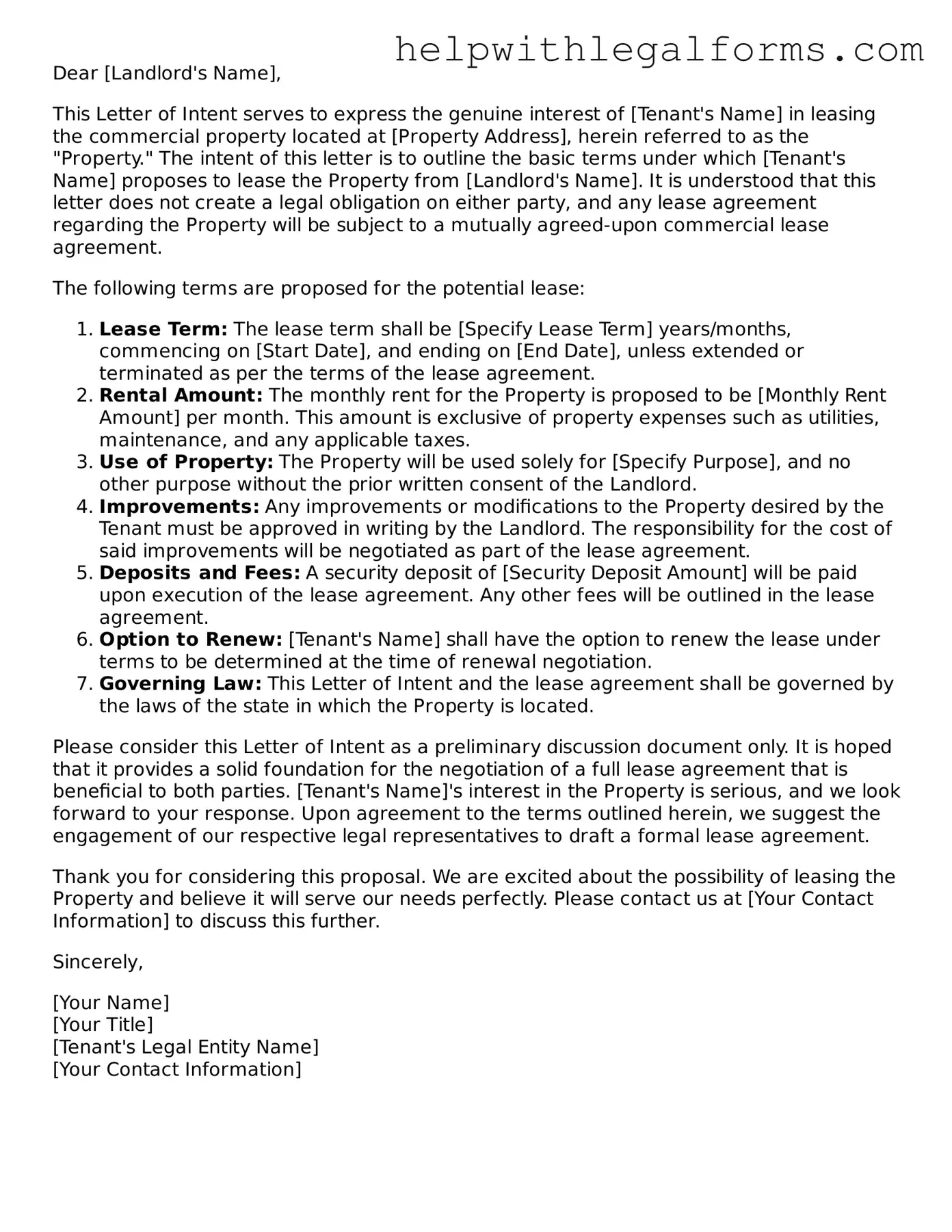What is a Letter of Intent to Lease Commercial Property?
A Letter of Intent to Lease Commercial Property is a preliminary agreement between a potential tenant and a landlord or property manager, outlining the primary terms and conditions under which the tenant proposes to lease a commercial space. It serves as a foundation for the lease agreement but is not legally binding regarding the lease itself. It typically includes terms such as lease duration, rent amount, property description, and any conditions or contingencies that need to be met before finalizing the lease.
Why use a Letter of Intent before leasing commercial property?
Using a Letter of Intent is a crucial step in the leasing process as it clearly outlines the expectations and obligations of both parties before entering into a binding lease agreement. It helps in negotiating terms and avoids misunderstandings by providing a written record of the proposed terms. Additionally, it demonstrates the tenant's serious interest in the property, which can be beneficial in competitive leasing environments.
Is a Letter of Intent legally binding?
Generally, a Letter of Intent itself is not legally binding in terms of obligating either party to finalize the lease. However, it can contain binding provisions regarding negotiation confidentiality, exclusivity period for negotiations, and any earnest money deposit terms. It's crucial to carefully review and understand which sections, if any, are intended to be legally binding.
What key information should be included in a Letter of Intent to Lease Commercial Property?
A comprehensive Letter of Intent should include the full names and contact information of both the prospective tenant and the landlord, a detailed description of the property, proposed lease term, rent amount, details on utilities and maintenance responsibilities, signage rights, any allowances for modifications, and conditions like obtaining financing or zoning approvals. It may also outline responsibilities for taxes, insurance, and repair obligations.
How do you negotiate the terms in a Letter of Intent?
Negotiating the terms in a Letter of Intent involves open communication and often, compromise between the potential tenant and the landlord. Prioritize your needs such as the length of the lease, monthly rent, and any tenant improvements. It's beneficial to understand the market conditions and the landlord's position to create a compelling offer. Sometimes, it may be helpful to engage a commercial real estate broker or a legal professional to negotiate on your behalf.
What happens after both parties sign the Letter of Intent?
After the Letter of Intent is signed by both parties, it typically signals the end of preliminary negotiations, and the focus shifts to drafting the formal lease agreement based on the terms outlined in the letter. It's important to proceed with due diligence, such as verifying the property's condition and ensuring compliance with local zoning laws. Professional legal advice may be sought to draft or review the lease agreement to ensure it accurately reflects the negotiated terms and protects your interests.
Can either party back out after signing a Letter of Intent?
Since the letter of intent is generally not considered legally binding in terms of the lease commitment, either party can technically back out before signing the official lease agreement. However, if there are any legally binding clauses within the letter, such as confidentiality or exclusivity agreements, those must still be honored. Backing out without just cause after signing a Letter of Intent, especially if it includes binding provisions, can sometimes lead to legal disputes over those specific terms.
How can a tenant terminate a Letter of Intent?
To terminate a Letter of Intent, a tenant should first review the document to ensure understanding of any binding clauses that might affect the termination process. If the letter allows for termination, the tenant should notify the landlord in writing according to the terms specified for termination, respecting any agreed notice periods. If there are no binding terms, a simple written statement expressing the decision not to proceed with the lease, ideally with a reasonable explanation, should suffice. It's always recommended to handle such matters professionally to maintain goodwill, as future opportunities could arise.
